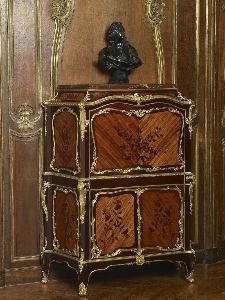Bernard Ii Vanrisamburgh
Bernard Ii Risamburgh;Bernard Ii Vanrisamburgh
Place: Paris
Biography:
Bernard II van Risamburgh, sometimes Risen Burgh (working by c 1730 — before February 1767) was a Parisian ébéniste of Dutch and French extraction, one of the outstanding cabinetmakers working in the Rococo style. His father, Bernard I van Risamburgh (died 1738), born in Groningen, was already working in Paris in 1696, when he was living in the heart of the furniture-making district, the Faubourg Saint-Antoine, and was marrying a Frenchwoman. Bernard II's initials BVRB stamped into the carcasses of his furniture, as was the requirement under the regulations of the Paris guild, long masked his actual identity, though the quality of work bearing the stamp Burb showed that the unidentified maker was in the forefront of his field. His full last name was a bit long to fit onto the metal maindron that punched the letters into the wood, rather than, as sometimes suggested, a symptom of enforced anonymity that would redound to the advantage of the marchands-merciers, the decorator-dealers for whom BVRB often worked. He is the Bernard who is occasionally mentioned in Parisian sale catalogues, which fact places him in the rarefied company of ébénistes whose names were familiar to connoisseurs, such as 'Boulle', 'Cressent', 'Oeben' and 'Riesener', the only other cabinetmakers ever mentioned by name. Bernard was already received as a master in the guild by the time the sequence of surviving books begins in 1735, and he was already working for the marchands-merciers, for his stamp appears on a commode veneered with lacquer panels that was delivered by the marchand-mercier Hébert for the use of Marie Lesczinska at Fontainebleau in 1737, and the trade card of Simon-Philippe Poirier, perhaps the best-known of the marchands-merciers, is sometimes found affixed to furniture stamped BVRB. Furniture that once belonged to Mme de Pompadour also bears his stamp and can even be recognized in her portraits. Bernard's furniture is brilliant in almost every respect. His carcasses are beautifully shaped, his mounts and marquetry are always in complete balance even when extremely elaborate, and there is a logic to his works that allows the eye to comprehend them effortlessly. His work is characterized by the use of marquetry of trails of leaves and flowers in end-cut quartered veneers, often of purplewood, sometimes highlighted with stained horn and ivory set in plain matched panels of veneers of tulipwood. The lacquer panels on many pieces of Bernard's output, such as the commode and two pairs of corner cabinets in the Royal Collection or the commode stamped BVRB at the Victoria and Albert Museum, or the uncharacteristically box-like pair of low cabinets in the goût grec in the Frick Collection, New York will have been supplied to him by the marchand-mercier who commissioned such pieces, for expensive Japanese lacquer cabinets and screens, to be disassembled and incorporated in the furniture, were out of the reach of a craftsman acting on his own. Their market, too, was at the point of entry, Amsterdam, as trade with Japan was firmly in the hands of the Dutch VOC Opperhoofden. An even more luxurious finish, employing Sèvres porcelain plaques, was invented by Poirier, apparently, for he maintained a monopoly of the factory's production of these; and Bernard was the first cabinetmaker to apply them to furniture: the earliest piece bearing porcelain plaques bears plaques of Vincennes porcelain, before the manufactory was taken under official royal patronage. Royal château marks and inventory numbers painted on many of his surviving works, related to corresponding entries in the day

